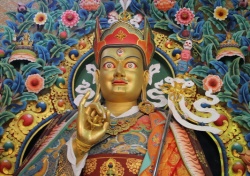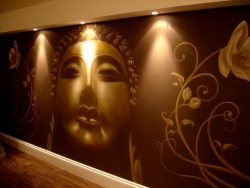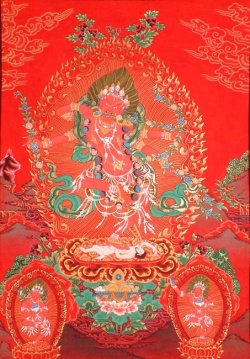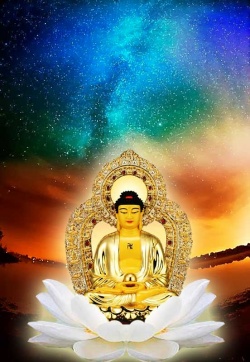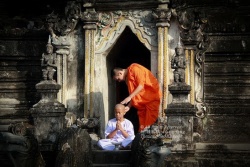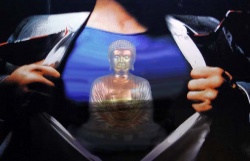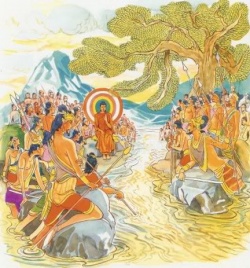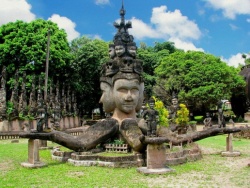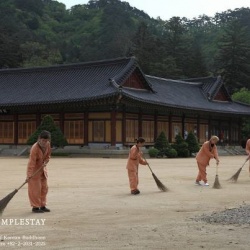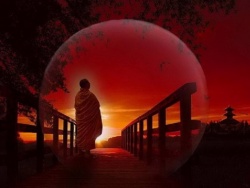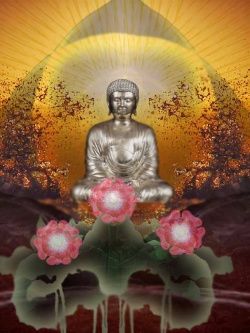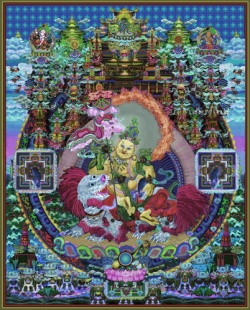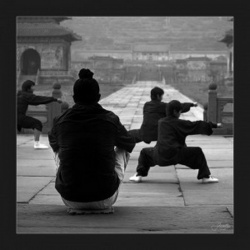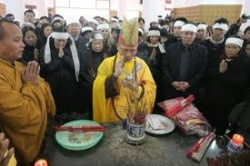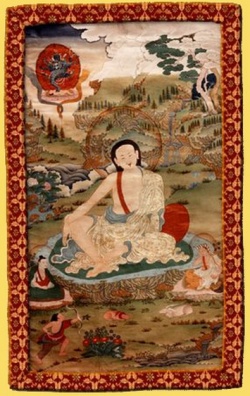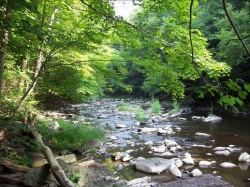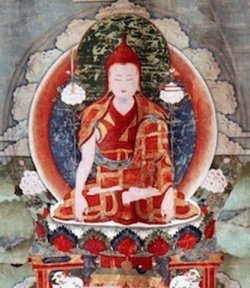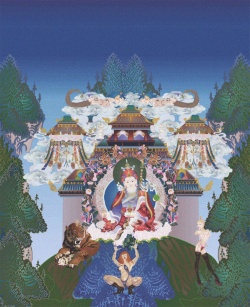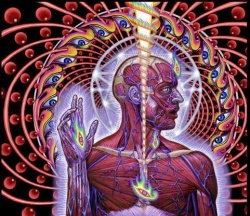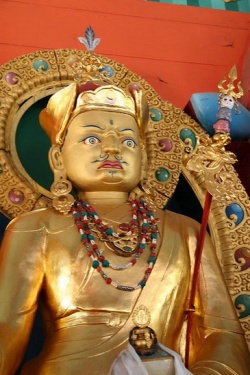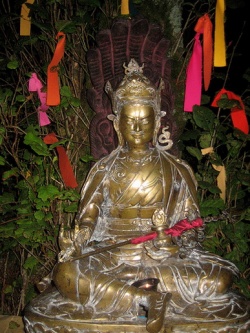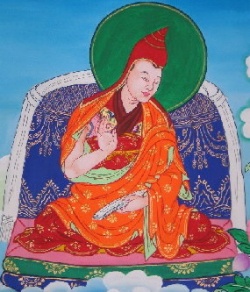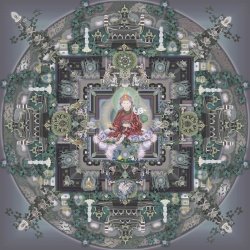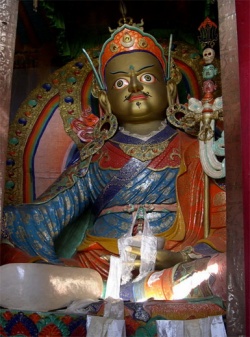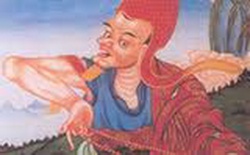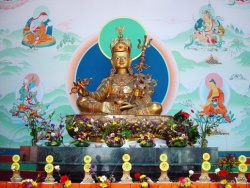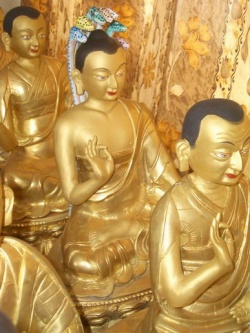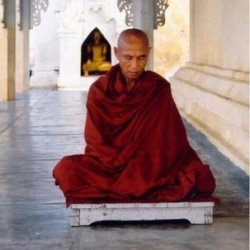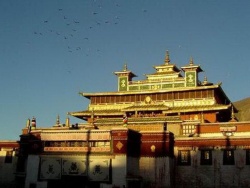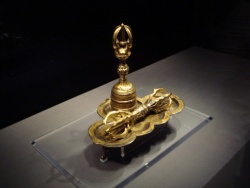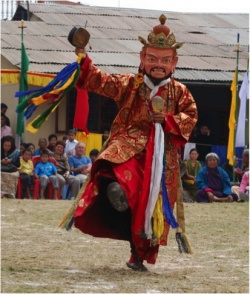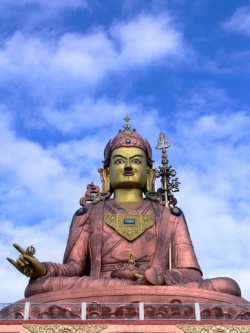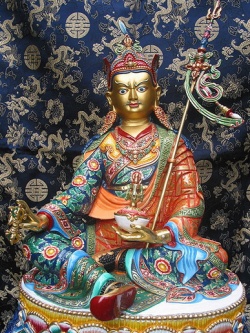Nyingma
Click here to see other articles relating to word Nyingma
The Nyingma Tradition is the oldest of the four major schools of Tibetan Buddhism (the other three being the Kagyu, Sakya and Gelug). "Nyingma" literally means "ancient," and is often referred to as Nga'gyur (Tibetan: སྔ་འགྱུར།, Wylie: snga 'gyur, ZYPY: Nga'gyur, school of the ancient translations) or the "old school" because it is founded on the first translations of Buddhist scriptures from Sanskrit into Tibetan, in the eighth century.
The Tibetan script and grammar was actually created for this endeavour.
In modern times the Nyingma lineage has been centered in Kham in eastern Tibet.
The Nyingma (rnying ma) -- literally the "ancient" -- is the oldest tradition of Tibetan Buddhism.
The origin of the Nyingma teachings is credited to Padmasambhava, a tantric ritual specialist invited to Tibet in the 8th century to subjugate native deities that were obstructing the dissemination of Buddhism.
Padmasambhava and other Indian masters such as Vimalamitra, and select Tibetan translators such as Vairocana, propagated the tradition's primary teaching, Dzogchen (rdzogs chen), a tantric system that has been adopted to varying degree by most other traditions.
The Indic scriptures that were translated in the 8th and 9th centuries and the teachings by the masters of that era have come to be known as the "Kama" (bka' ma), or spoken word tradition.
Since at least the 12th century Nyingma teachers known as terton (gter ston), or "treasure revealers" have produced new scriptures said to have been concealed by Padmasambhava or others for the benefit of future eras.
The Nyingma maintains both lay and monastic traditions, with six mother monasteries:
Dorje Drak (rdo rje brag) and
Mindroling (smin grol gling) in Tibet,
and
and Shechen (zhe chen) in Kham.
Early lineage and traditions
The Nyingmapa, a Red Hat sect of Tibetan Buddhism, incorporate mysticism and local deities shared by the pre-Buddhist Bon religion, which has shamanic elements.
The group particularly believes in hidden Terma treasures. Traditionally, Nyingmapa practice was advanced orally among a loose network of lay practitioners.
Monasteries with celibate monks and nuns, along with the practice of reincarnated spiritual leaders are later adaptations.
The Nyingma Tradition actually comprises several distinct lineages that all trace their origins to the Indian master Padmasambhava, who is lauded in the popular canon as the founder of Tibetan Buddhism in the 8th century, and is still propitiated in the discipline of reciprocity that is [[Guru yoga] sadhana]], the staple of the tradition(s).
Historically, Nyingmapa are categorised into Red Sangha and White Sangha.
Red Sangha denotes a celibate, monastic practitioner; whereas White Sangha denotes a non-celibate practitioner who abstains from vows of Celibacy.
At different times in one's Life, due to changing circumstances and proclivities, individuals historically moved between these two Sanghas. Rarely was either determination of Red or White for the duration of one's Life.
Nyingma maintains the earliest tantric teachings which have been given the popular nomenclature of Vajrayana.
Early Vajrayana that was transmitted from India to Tibet may be differentiated by the specific term 'Mantrayana' (Wylie: sngags kyi theg pa).
'Mantrayana' is the Sanskrit of what became rendered in Tibetan as "Secret Mantra" (Wylie: gsang sngags): gsang sngags is the self-identifying term employed in the earliest literature, whereas Nyingma became associated in differentiation from the "New Schools" Sarma.
History
Geographical dissemination of Buddhism into the Tibetan plateau
Dargyay (1998: p. 5) provides a sound case that:
...at least in Eastern Tibet, there existed during and after the time of Lha-tho-tho-ri [Fl.173(?)-300(?) CE] a solid knowledge of Buddhism and that the upper classes of the people were faithfully devoted to it.
But the border regions in the north and west probably had also come into contact with Buddhism long before the time of Srong-btsan-sgam-po.
Buddhist teachings reached China via a route along the western and northern borders of the Tibetan culture and Language zone;
the same route was travelled by Indian Pandits and Chinese pilgrims in their endeavour to bring this Indian religion to China.
There used to be contacts with the Tibetan population in these border regions.
It is possible that the knowledge gained from these encounters was spread by merchants over large areas of Tibet.
Thus, when Srong-btsan-sgam-po succeeded to the throne of Tibet in the year 627, the country was ready for a systematic missionary drive under royal patronage.
Origins
Around 760, King Trisong Detsen invited Padmasambhava and the Nalanda University abbot Shantarakshita (Tibetan Shiwatso) to Tibet to introduce Buddhism in the "Land of Snows."
King Trisong Detsen ordered the translation of all Buddhist Dharma Texts into Tibetan.
Padmasambhava, Shantarakshita, 108 translators, and 25 of Padmasambhava's nearest disciples worked for many years in a gigantic translation-project.
The translations from this period formed the base for the large scriptural transmission of Dharma teachings into Tibet.
Padmasambhava supervised mainly the translation of Tantra; Shantarakshita concentrated on the Sutra-teachings.
Padmasambhava and Shantarakshita also founded the first Buddhist monastery Samye on Tibetan ground. It was the main center for dharma transmission in Tibet during this age.
25 disciples
The miracle-powers of the 25 disciples of Padmasambhava are widely accepted among Tibetan Buddhists.
These disciples were:
King Trisong Detsen, Namkhai Nyingpo, Nub Chen Sangye Yeshe, Gyalwa Choyang, the princess of Karchen Khandro Yeshe Tsogyal, Palgyi Yeshe, Palgyi Senge, the great translator Vairotsana, Nyak Jnanakumara, Gyalmo Yudra Nyingpo, Nanam Dorje Dudjom, Yeshe Yang, Sokpo Lhapal, Nanam Zhang Yeshe De, Palgyi Wangchuk, Denma Tsémang, Kawa Paltsek, Shupu Palgyi Senge, Dré Gyalwe Lodro, Drokben Khyenchung Lotsawa, Otren Palgyi Wangchuk, Ma Rinchen Chok, Lhalung Palgyi Dorje, Langdro Konchog Jungné and Lasum Gyalwa Changchup.
Early period
From this basis, Tantric Buddhism was established in its entirety in Tibet.
From the 8th until the 11th century, the Nyingma was the only school of Buddhism in Tibet.
With the reign of King Langdarma (836–842) a time of political instability ensued which continued over the next 300 years, during which time Buddhism was persecuted and largely forced underground.
From the 11th century onwards, the Nyingma tradition flourished along with the newer Sarma schools, and it was at that time that Nyingmapas began to see themselves as a distinct group and the term "Nyingma" came into usage.
Tantra and Dzogchen texts and praxis in the Nyingma tradition
With the advent of the transmission of Sarma traditions into Tibet, various proponents of the new systems cast aspersions on the Indic orgins of much of the Nyingma esoteric corpus.
Indic origin was an important component of perceived legitimacy at the time.
As a result, much of the Nyingma esoteric corpus was excluded from the Tengyur, a compilation of texts by Buton Rinchen Drub that became the established canon for the Sarma traditions.
In response, the Nyingmapas organized their esoteric corpus, comprising mostly Mahayoga, Atiyoga (Dzogchen) Mind class Semde and Space Class (Longde) texts, into an alternate collection, called the Nyingma Gyubum
(the Hundred Thousand Tantras of the Ancient School, Wylie: rnying ma rgyud ‘bum).
Generally, the Gyubum contains Kahma (Wylie: (bka' ma) and very little terma (Wylie: gter ma).
The third class of Atiyoga, the Secret Oral Instructions (Menngagde), are mostly terma texts.
Various editions of the Gyubum are extant, but one typical version is the thirty-six Tibetan language folio volumes published by Dilgo Khyentse Rinpoche in New Delhi, 1974.
It contains:
10 volumes of Ati Yoga (Dzogchen)
3 volumes of Anu Yoga
6 volumes of the tantra Section of Mahayoga
13 volumes of the sadhana Section of Mahayoga
1 volume of protector tantras
3 volumes of catalogues and historical background
Eighteen great tantras of Mahayoga
There are 'eighteen great tantras' (Wylie: bshad pa dang cha mthun gyi rgyud tantra sde bco brgyad) at the heart of the Mantrayana 'Mahayoga' (Wylie: rnal 'byor chen po) tradition, grouped into
'five root tantras' (Wylie: rtsa ba sku gsung thugs yon tan phrin las kyi rgyud chen po lnga),
'five practice tantras' (Wylie: sgrub pa lag len du bstan pa rol pa' rgyud chen po lnga), and
'five activity tantras' (Wylie: spyod pa'i yan lag tu 'gro ba'i rgyud chen po lnga), and the
'two supplementary tantras' (Wylie: ma tshang kha bskong ba'i rgyud chen po gnyis).
==Together they are known as the Māyājāla==.
They are as follows: The "Guhyagarbha Tantra" (Wylie: rDo rje sems dpa' sgyu 'phrul drwa ba; gSang ba snying po) is the foremost of all of these and it abridges the content of the seventeen others as follows:
==Root tantras==:
Equalizing Buddhahood (the tantra of the body) (Wylie: Sangs rgyas mnyam sbyor gyi rtsa ba mkha' 'gro ma bde mchog rtsa ba'i rgyud) The Secret Moon, (the tantra of speech) (Wylie: dPal Zla gsang thig le rtsa ba'i rgyud) The Assembly of Secrets (Guhyasamaja Tantra) (the tantra of mind) (Wylie: dPal gSang ba 'dus pa) The Glorious Supreme Primal Tantra (the tantra of qualities) (Wylie: dPal mchog dang po) The Activity Garland Tantra (the tantra of activities) (Wylie: Kar ma ma le)
==Practice tantras==:
The Heruka Practice Tantra (Wylie: He ru ka rol pa'i rgyud)
The Hayagriva Supreme Practice Tantra (Wylie: rTa mchog rol pa'i rgyud)
The Compassion Tantra (Wylie: sNying rje rol pa'i rgyud)
The Nectar Practice Tantra (Wylie: bDud rtsi rol pa'i rgyud)
The Arising of the Twelve Kilayas Tantra (Wylie: Byit to ta ma rol pa'i rgyud; Phur pa bcu gnyis)
==Activity Tantras==:
The Mountain Pile (Wylie: [[Go 'phang dbang gis bgrod pa ri bo brtsegs pa'i rgyud)
The Lightning (Wylie: La spyod pas dor ba rngam pa glog gi 'khor lo'i rgyud)
The Array of Samayas (Wylie: gZhi dam tshigs gis bzung ba bkod pa rgyal po'i rgyud)
The One-Pointed Samadhi (Wylie: Nyams su ting 'dzin gyis blangs pa rtse gcig bsdus pa'i rgyud)
The Rampant Elephant (Wylie: 'Phang lta bas bcad pa glang po rab 'bog gi rgyud)
==Last Tantras that complete whatever is incomplete:==
The Vairochana Net of Magical Display (Wylie: rNam par snang mdzad sgyu 'phrul drwa ba'i rgyud)
The Noble, Skilful Lasso, the Concise Lotus Garland (Wylie: Thabs kyi zhags pa pad mo'i phreng ba'i rgyud)
"Eighteen" Texts of the Mind Division (Semde) The mind class (semde) of Dzogchen was also said to comprise eighteen tantras, although the formulation eventually came to include slightly more.
==Tantras belonging to the Mind Division include:==
Rigpa'i Khuchug (Cuckoo of Presence)
Tsalchen Trugpa (Great Potency)
Khyungchen Dingwa (Great Garuda in Flight)
Dola Serzhun (Refining Gold from Ore)
Minubpa'i Gyaltshen Dorje Sempa Namkhache (The Victory Banner that Does Not Wane - Total Space of Vajrasattva)
Tsemo Chung-gyal (Supreme Peak)
Namkha'i Gyalpo (King of Space)
Dewa Thrulkod (Jewel-Encrusted Bliss Ornament)
Dzogpa Chiching (All-Encompassing Perfection)
Changchub Semtig (Essence of Bodhicitta)
Dewa Rabjam (Infinite Bliss)
Sog-gi Khorlo (Wheel of Life)
Thigle Trugpa (Six Spheres)
Dzogpa Chichod (All-Penetrating Perfection)
Yidzhin Norbu (Wish-Fulfilling Jewel)
Kundu Rigpa (All-unifying Pure Presence)
Jetsun Tampa (Supreme Lord)
Gonpa Tontrub (The Realization of the True Meaning of Meditation)
Kunjed Gyalpo (Sanskrit: Kulayarāja Tantra; The All-Creating King)
Medchung Gyalpo (Wonderous King)
Dochu (The Ten Concluding Teachings)
Of these, the first five are the "Five Earlier Translated Tantras", translated by Vairotsana.
The next thirteen were translated primarily by Vimalamitra.
Of the remaining three, the Kunjed Gyalpo is taken to be the primary or root tantra of the Mind Series.
Germano (2002: unpaginated) states:
While Buddhist figures and movements surely were active on the Tibetan plateau long before, Tibetan religious histories concentrate on events in the latter half of the eighth century as marking a watershed during which Buddhism definitively established itself within Tibetan culture.
With the official sponsorship of the emperor Trisong Detsen (khri srong lde btsan), the first major monastery was established at Samye (bsam yas), a broad scale translation project of the Buddhist canon into a newly minted Tibetan literary Language was initiated, and a variety of lineages began to take hold.
The explosive developments were interrupted in the mid-ninth century as the Empire began to disintegrate, leading to a century-long interim of civil war and decentralization about which we know relatively little.
Around 760, King Trisong Detsen invited Padmasambhava and the Nalanda University abbot Śāntarakṣita (Tibetan Shiwatso) to Tibet to introduce Buddhism in the "Land of Snows."
King Trisong Detsen ordered the translation of all Buddhist Dharma Texts into Tibetan.
Padmasambhava, Shantarakṣita, 108 translators, and 25 of Padmasambhava's nearest disciples worked for many years in a gigantic translation-project.
The translations from this period formed the base for the large scriptural transmission of Dharma teachings into Tibet.
Padmasambhava supervised mainly the translation of Tantra;
Shantarakshita concentrated on the Sutra-teachings.
Padmasambhava and Shantarakshita also founded the first Buddhist monastery Samye on Tibetan ground.
It was the main center for Dharma transmission in Tibet during this age.
==25 disciples==
The miracle-powers of the 25 disciples of Padmasambhava are widely accepted among Tibetan Buddhists.
==These disciples were ==
King Trisong Detsen,
Namkhai Nyingpo,
Nub Chen Sangye Yeshe,
Gyalwa Choyang,
the princess of Karchen Khandro Yeshe Tsogyal,
Palgyi Yeshe,
Palgyi Senge,
the great translator Vairotsana,
Nyak Jnanakumara,
Gyalmo Yudra Nyingpo,
Nanam Dorje Dudjom,
Yeshe Yang,
Sokpo Lhapal,
Nanam Zhang Yeshe De,
Palgyi Wangchuk,
Denma Tsémang,
Kawa Paltsek,
Shupu Palgyi Senge,
Dré Gyalwe Lodro,
Drokben Khyenchung Lotsawa,
Otren Palgyi Wangchuk,
Ma Rinchen Chok,
Lhalung Palgyi Dorje,
Langdro Konchog Jungné and
Lasum Gyalwa Changchup.
==Early period==
From this basis, Tantric Buddhism was established in its entirety in Tibet.
From the 8th until the 11th century, the Nyingma was the only school of Buddhism in Tibet.
With the reign of King Langdarma (836–842) a time of political instability ensued which continued over the next 300 years, during which time Buddhism was persecuted and largely forced underground.
From the 11th century onwards, The Nyingma Tradition flourished along with the newer Sarma schools, and it was at that time that Nyingmapas began to see themselves as a distinct group and the term "Nyingma" came into usage.
==Political ethos==
Historically, The Nyingma Tradition is unique amongst the four schools in that its supporters never held political Power, and therefore its practitioners were mostly removed from the political machinations of Tibet.
Indeed, the Nyingma traditionally had no centralized authority and drew significant Power from not having one.
Only since the Tibetan diaspora following the Chinese annexure of Tibet have the Nyingma had a head of the Tradition and this seat was only invested at the polite request of the Dalai Lama.
Even so, The Nyingma Tradition is still politically decentralized and often decisions are made in an oligarchy or community of the senior Sangha within a given jurisdiction or locale.
Nyingmapa are also historically characterized and distinguished by decentralization and by their general wider political disinterest, with a lesser emphasis on monasticism relative to the other schools, with a correspondingly greater preponderance of ngakpas, uncelibate householders and yogins.
There was never a single "head of the lineage" in the manner of either the Ganden Tripa or Dalai Lama of the Gelugpa, the Karmapa of the Karma Kagyu, or the Sakya Trizin of the Sakya.
It was only recently in exile in India that this role was created at the request of the Tibetan Government in Exile, and it is largely administrative. Nevertheless, the lamas who have served in this role are among the most universally highly regarded.
==They are:==
Dudjom Rinpoche (c. 1904–1987), served from the 1960s until his Death.
Dilgo Khyentse Rinpoche (c. 1910–1991), served from 1987 until his Death.
Penor (Pema Norbu) Rinpoche (1932–2009) served from 1991 until retirement in 2003.
Mindroling Trichen Rinpoche (c. 1930–2008), served from 2003 until his Death.
Trulshik Rinpoche (1923–2011), served from 2010 until his Death on September 2, 2011. Selected after Chatral Rinpoche declined the position.
Taklung Tsetrul Rinpoche (b.1926) accepted this position on 22 March 2012.
==Rise of scholasticism and monasticism==
In 1848, Dzogchen Shri Sengha (rdzogs chen srwi sengha), was founded by a charismatic teacher, Zhanphan Thaye (gzhan phan mtha' yas, 1800-), in association with the active participation of Do Kyentse (rndo mkhyen rtse).
==As scholar Georges Dreyfuss reports==,
The purpose of this school was not . . . the study of the great Indian treatises . . . but the development of Nyingma monasticism in Kham, a particularly important task at that time.
Up to then, The Nyingma Tradition had mostly relied on non-ordained tantric practitioners to transmit its teachings through authorized lineages.
The move toward monasticism changed this situation, putting a greater emphasis on the respect of exoteric moral norms of behavior as a sign of spiritual authority.
This move participated in the logic animating the nonsectarian movement, the revitalization of non-Geluk traditions so that they could compete with the dominant Geluk school.
Since the Geluk hegemony was based on a widespread monastic practice, it was important for the other schools to develop their own monasticism to rival the dominant Geluk tradition.
This seems to have been one the goals of Zhanphan Thaye in creating the Dzokchen commentarial school. . . .A further and equally important step was taken a few decades later with the transformation by Khenpo Zhenga of this institution into a center devoted to the study of the exoteric tradition.
This step was decisive in creating a scholastic model that could provide an alternative to the dominant model of the Geluk seats and could train scholars who could hold their own against the intellectual firing Power of Geluk scholars.
For Zhenga and his followers, the way to return to this past was the exegetical study of commentaries, the proper object of scholarship.
By downplaying the role of debate emphasized by the Geluk monastic seats and stressing exegetical skills, they accentuated the differences between these two traditions and provided a clear articulation of a non-Geluk scholastic tradition.
In this way, they started the process of reversal of the damage inflicted on the non-Geluk scholarly traditions and created an alternative to the dominance of Geluk scholasticism, which had often tended to present itself in Tibet as the sole inheritor and legitimate interpreter of the classical Indian Buddhist tradition.
This scholastic movement led by Khenpo Shenga came on the heels of the work of Mipham, who "completely revolutionised rNying ma pa scholasticism in the late 19th century, raising its status after many centuries as a comparative intellectual backwater, to arguably the most dynamic and expansive of philosophical traditions in all of Tibetan Buddhism, with an influence and impact far beyond the rNying ma pa themselves."
==Chinese influence==
Tibetan king Khri srong lde btsan (742–797) invited the Chan master Mo-ho-yen (whose name consists of the same Chinese characters used to transliterate “Mahayana”) to transmit the Dharma at Samye Monastery.
Mo-ho-yen had been disseminating Dharma in the Tun-huang locale, but, according to Tibetan sources, lost an important philosophical debate on the nature of Emptiness with the Indian master Kamalaśīla, and the king declared Kamalaśīla's philosophy should form the basis for Tibetan Buddhism.
However, a Chinese source says their side won, and some scholars conclude that the entire episode is fictitious.
Pioneering Buddhologist Giuseppe Tucci speculated that Hwashang's ideas were preserved by the Nyingmapas in the form of dzogchen teachings.
According to A. W. Barber of the University of Calgary, Chan Buddhism was introduced to the Nyingmapa in three principal streams:
the teachings of Korean Master Kim, Kim Ho-shang, (Chin ho shang) 金和尚 transmitted by Sang Shi in ca. 750 AD; the lineage of Master Wu Chu (無住禪師) of the Pao T'ang School was transmitted within Tibet by Ye-shes Wangpo;
and the teaching from Mo Ho Yen, 和尚摩訶衍 (Tibetan: Hwa shang Mahayana) that were a synthesis of the Northern School of Chan and the Pao T'ang School.
==John Myrdhin Reynolds and Sam van Schaik hold a very different point of view==.
Reynolds states "Except for a brief flirtation with Ch'an in the early days of Buddhism in Tibet in the eighth century, the Tibetans exhibited almost no Interest at all in Chinese Buddhism, except for translating a few Sutras from Chinese for which they did not possess Indian originals."
Schaik emphasises that Chan and Dzogchen are based on two different classes of scripture, Chan being based on sutras, while Dzogchen being based on tantras.
==Schaik further states "apparent similarities can be misleading.=="[16]
It was Guru Rinpoche himself who invited a whole host of Chinese Buddhist masters to the great Samye Monastery during the eight century, and that's why he built Samye in three levels representing the three Dharma nations of India, China and Tibet.
If Guru Rinpoche thought that the Chinese monks he invited to Samye were qualified to transmit the Dharma in Tibet then they probably were.
China had already been an extraordinary Dharma nation for eight hundred years and Guru Rinpoche's teacher Shri Singha was also Chinese.
The Vajrayana traveled [[The Silk Road]] to China one hundred years before the birth of Guru Rinpoche with Vajrabodhi being it's main proponent and there were over ten major schools of Buddhism in China at that time.
Chinese monks are strict vegetarians and probably left Samye when Guru Rinpoche left, and their job of transmitting the Dharma was over.
One Monk, Huashang, was said to remain and participated in a "great debate", and after he was defeated left, however, one Monk does not represent the entire Dharma nation of China or Tibet.
Like the entire Samye Monastery compound, Samye Village, and Samye County the Chinese compound at Samye has been wonderfully restored in the past decade, and while all of the different chapels and compounds are designated for different teachings the Chinese compound still represents the teachings of the Prajnaparimita and Chan.
Samye Monastery has many chapels, university and tantric college.
There are currently over a thousands monks, and nagpas in residence and every year graduates a host of Khenpos.
==Samye also hosts great masters from all over Tibet and China to disseminate the Nyingma Dharma==.
Chinese Mahayana Buddhism had been introduced to Tibet for centuries by waves of Chinese migrations, various merchants and missions, but the Princess Wen Cheng, wife of King Songtsen Gampo and an emanation of Tara, was especially influential in transmitting the Dharma in Tibet in the eighth century.
She's the one who brought Tibet's most famous Buddhist statue, the Jowo Shakyamuni, from China as well as Buddhist teachers, a treasure trove of Mahayana sutras, five different types of grain, medicinal plants and Chinese inventions.
It was the Chinese Emperor Gongzi who introduced Chinese Astrology, fengshui, medicine and operatic musical instruments to Tibet.
However, it was through the inconceivable efforts and Siddhis of Guru Rinpoche that he combined the dharmas of all his own masters and his invited teachers to established the nine vehicles of Buddhism at the inconceivable Samye Monastery and transformed the entirety of Tibet into a Dharma nation Blessing every molecule along the way.
Where Chinese Mahayana was practiced in the royal court of Songtsen Gampo, under the eighth century King Trisong Detsun and Guru Rinpoche the Dzogchen and Chan (Zuo Chan) schools became the pinnacle of Buddhist realization, which goes beyond scriptural interpretations, historical speculations, and intellectual machinations.
==Distinguishing features of the Nyingma lineage==
==Nine Yanas==
The doxography employed by The Nyingma Tradition to categorize the whole of the Buddhist path is unique. Nyingmapas divide the Buddhist path into nine yanas, as follows:
==The Sutra System==
Shravakayana (Hinayana) the Vehicle of the Listeners or disciples.
Pratyekayana (Hinayana) the Vehicle of the Solitary Buddhas, the way of solitary meditation.
Bodhisattvayāna (Mahayana) the Great or Causal Vehicle, the Vehicle of Enlightened Beings, is the way of those who seek or attain Enlightenment for the sake or intention of liberating not just oneself, but all Sentient beings from Saṃsāra.
==Outer/Lower Tantra==
Kriya (Wylie: bya ba'i rgyud) Tantra of Action
Carya or Ubhaya (Wylie: u pa'i rgyud or spyod pa'i rgyud) Tantra of Conduct
Yogatantra (Wylie: rnal 'byor gyi rgyud) Tantra of Union
==Inner/Higher Tantra==
Mahayoga (Wylie: chen po'i rnal 'byor) Great Yoga
Anuyoga (Wylie: rjes su rnal 'byor) Subsequent Yoga
Atiyoga/Dzogchen (Wylie: lhag pa'i rnal 'byor or rdzogs chen) Ultimate Yoga; The Great Perfection
In the later schools the inner tantric teachings are known as Anuttarayogatantra, which corresponds to Mahayoga in the Nyingma system, while the Mahamudra teachings of the later schools are said to lead to similar results as the Dzogchen teachings.
Dzogchen Rinpoche (2007: p. 89) holds that:
When we study and practice the so-called lower and higher yanas, we might hear that the most sublime, or the pinnacle of all teachings are those of dzogchen, and this is true.
The "lower" yanas of the Shravaka and Bodhisattva paths, the "higher" paths of the tantras, and the "pinnacle" path of dzogchen are distinguished from one another in this way.
This gradation shows the various ways in which it is appropriate for beings of differing propensities to proceed upon the path.
Ideally, a practitioner proceeds from the lower levels of practice to the higher levels, and then to the summit.
This does not mean that the lower levels of practice are to be disparaged or ignored. We should not focus on the higher paths at the expense of the lower paths...".
Philosophy and doctrinal tenets
Capriles (2003: p. 100) elucidates the Nyingma Dzogchenpa view which qualifies the doctrinal position of the Madhyamaka Rangtongpa (Prasangika and Svatantrika) in relation to the 'absence of self-nature' (Sanskrit: swabhava Shunyata):
Though the teachings of the Nyingmapa agree that all phenomena lack a self-nature and a substance, according to many Nyingma teachings reducing voidness to a mere absence would be an instance of nihilism, and identifying absolute truth with such an absence would imply that this truth cannot account for the manifestation of Awakening, or even for the manifestation of phenomena; therefore, they explain voidness as lying in the recognition of the absence of mental constructs that is inherent in the essence of mind in which space and awareness are indivisible, and define absolute truth as consisting in the indivisibility of Emptiness and appearances, or of Emptiness and awareness.
The following sentence is from Mipham's famed exegesis of Shantarakshita's Madhyamakalamkara and it foregrounds the relationship between the absence of the 'four extremes' (mtha' bzhi) and the nondual or 'indivisible Two Truths' (bden pa dbyer med), the Wylie is a transcription from Doctor (2004: p. 126), the first English rendering is by Doctor (2004: p. 127) and the second is by Blankleder and Fletcher of the Padmakara Translation Group (2005: p. 137):
"The learned and accomplished (masters) of the Early Translations considered this simplicity beyond the four extremes, this abiding way in which the two truths are indivisible, as their own immaculate way" (Doctor, 2004: p.127).
de lta bu'i mtha' bzhi'i spros bral bden pa dbyer med kyi gnas lugs 'di la snga 'gyur gyi mkhas grub rnams kyis rang lugs dri ma med par bzung nas (Doctor, 2004: p.126).
"The learned and accomplished masters of the Old Translation school take as their stainless view the freedom from all conceptual constructs of the four extremes, the ultimate reality of the two truths inseparably united" (Padmakara Translation Group, 2005: p.137).
Tantra and Dzogchen texts and praxis in The Nyingma Tradition
With the advent of the transmission of Sarma traditions into Tibet, various proponents of the new systems cast aspersions on the Indic origins of much of the Nyingma esoteric corpus.
Indic origin was an important component of perceived legitimacy at the time.
As a result, much of the Nyingma esoteric corpus was excluded from the Tengyur, a compilation of texts by Buton Rinchen Drub that became the established canon for the Sarma traditions.
In response, the Nyingmapas organized their esoteric corpus, comprising mostly Mahayoga, Atiyoga (Dzogchen) Mind class Semde and Space Class (Longde) texts, into an alternate collection, called the Nyingma Gyubum (the Hundred Thousand Tantras of the Ancient School, Wylie: rnying ma rgyud ‘bum).
Generally, the Gyubum contains Kahma (Wylie: bka' ma) and very little Terma (Wylie: gter ma). The third class of Atiyoga, the Secret Oral Instructions (Menngagde), are mostly Terma texts.
Various editions of the Gyubum are extant, but one typical version is the thirty-six Tibetan-Language folio volumes published by Dilgo Khyentse Rinpoche in New Delhi, 1974. It contains:
10 volumes of Ati Yoga (Dzogchen) 3 volumes of Anu Yoga 6 volumes of the tantra Section of Mahayoga 13 volumes of the sadhana Section of Mahayoga 1 volume of protector tantras 3 volumes of catalogues and historical background
Mahayoga
There are 'eighteen great tantras' (Wylie: bshad pa dang cha mthun gyi rgyud tantra sde bco brgyad) at the Heart of the 'Mahayoga' (Wylie: rnal 'byor chen po) tradition, grouped into 'five root tantras' (Wylie: rtsa ba sku gsung thugs yon tan phrin las kyi rgyud chen po lnga), 'five practice tantras' (Wylie: sgrub pa lag len du bstan pa rol pa' rgyud chen po lnga), and 'five activity tantras' (Wylie: spyod pa'i yan lag tu 'gro ba'i rgyud chen po lnga), and the 'two supplementary tantras' (Wylie: ma tshang kha bskong ba'i rgyud chen po gnyis).
Together they are known as the Māyājāla.
The Guhyagarbha Tantra (Wylie: rDo rje sems dpa' sgyu 'phrul drwa ba gSang ba snying po) is the foremost of all of these and it abridges the content of the seventeen others.
"Eighteen" Texts of the Mind Division (Semde)
The mind class (semde) of Dzogchen was also said to comprise eighteen tantras, although the formulation eventually came to include slightly more.
The Kunjed Gyalpo (Sanskrit: Kulayarāja Tantra; The All-Creating King) Tantras is the most significant of the group and is taken to be the primary or root tantra of the Mind Series.
The first five are the "Five Earlier Translated Tantras", translated by Vairotsana.
The next thirteen were translated primarily by Vimalamitra.
Yidam practice & Protectors
The foremost deities practiced by the Nyingma masters are Vajrakīla (Tib. Dorje Phurba) and Vajra Heruka (also Vishuddha Heruka; Tib. Yangdak Tratung, Wylie: yang dag khrag 'thung), the third of the Eight Herukas who closely resembles Śrī Heruka of the Chakrasamvara tantra.
The three principle Protectors of the Nyingma lineage are said to be Ekajaṭī (Wylie: e ka dza ti), Rāhula (Wylie: gza' ra hu la) and Dorje Legpa (Wylie: rdo rje legs pa, Sanskrit: Vajrasādhu).
Termas and tertons
The appearance of Terma ("hidden treasures") is of particular significance to The Nyingma Tradition.
Although there have been a few Kagyupa "tertons" (treasure revealers) and the practice is endemic to the Bönpo as well, the vast majority of Tibetan Buddhist tertons have been Nyingmapas.
It is held that past masters, principally Padmasambhava, secreted objects and hid teachings for discovery by later tertons at appropriate and auspicious times such that the teaching would be beneficial.
These teachings may be physically discovered, often in rocks and Caves, or they may be "mind Terma," appearing directly within the Mindstream of the Terton.
Terma
Padmasambhava and his main disciples hid hundreds of scriptures, ritual objects and relics in secret places to protect Buddhism during the time of decline under King Langdarma.
These termas were later rediscovered and special Terma lineages were established throughout Tibet.
Out of this activity developed, especially within The Nyingma Tradition, two ways of Dharma transmission: the so-called "long" oral transmission from teacher to student in unbroken lineages and the "short" transmission of "hidden treasures".
The foremost revealers of these termas were the five Terton kings and the eight Lingpas.
The Terma tradition had antecedents in India; Nagarjuna, for example, rediscovered the last part of the "Prajnaparamita-Sutra in one hundred thousand verses" in the realm of Naga, where it had been kept since the time of Buddha Shakyamuni. Tertons
==According to Nyingma tradition, tertons are often Mindstream emanations of the 25 main disciples of Padmasambhava==.
A vast system of transmission lineages developed through the ages.
Nyingma scriptures were updated when the time was appropriate.
Terma teachings guided many Buddhist practitioners to realisation and Enlightenment.
The rediscovering of Terma began with the first Terton, Sangye Lama (1000–1080).
Tertons of outstanding importance were
Nyangral Nyima Oser (1124–1192), Guru Chowang (1212–1270), Rigdzin Godem (1307–1408), Pema Lingpa (1450–1521), Migyur Dorje (1645–1667), Jamyang Khyentse Wangpo (1820–1892) and Orgyen Chokyur Lingpa (1829–1870).
In the 19th century some of the most famous were the Khen Kong Chok Sum referring to Jamyang Khyentse, Jamgon Kongtrul and Chokgyur Lingpa.
Various traditions and important historical figures
It is generally agreed that Rongzom Pandita, Longchenpa and Ju Mipham are three of the greatest scholars in the history of the Nyingma lineage.
Also important in establishing the modern curriculum was Khenpo Shenga.
Longchenpa (1308-1363)
During the ages, many great scholars and tantric Masters appeared within the Nyingma lineage.
Most famous of all is the master and scholar Longchenpa (Longchen Rabjam), who, along with Rongzom Pandita, and Jigme Lingpa are known as kun kyen or "omniscient ones" - a rare title denoting doctrinal infallibility.
He wrote many scriptures on the whole Nyingma-Dharma.
He is especially known for his presentation of the Nyingma philosophical view, that of Dzogchen in particular.
His main works are the "Seven Treasuries" (Dzö dün), "three cycles of relaxation" (Ngalso Korsum), "three cycles of natural liberation" (Rangdröl Korsum) and the three "inner essences" (Yangtig Namsum).
Longchen Rabjam also systematized the transmission of Dzogchen, the Great Perfection, in a collection of texts called "The Four-fold Heart Essence)]" (Nyingthig Yabzhi).
Jigme Lingpa (1730-1798) and the Longchen Nyingthig
Jigme Lingpa further condensed the Nyingthig Yabzhi of Longchenpa into a cycle of termas called the Longchen Nyingthig, or "Heart Essence of the Vast Expanse".
The Nyingthig Yabshi and the Longchen Nyingthig are known, respectively, as the earlier and later "Heart essence."
The Longchen Nyingthig became both the foundation of the main Dzogchen teachings in the contemporary period and of the Rime movement.
Jigme Lingpa's teaching lineage flourished in Kham (eastern Tibet) around Dege, and after his Death three incarnations were recognised as being his emanations:
Do Khyentse (1800?-1859?), Jamyang Khyentse Wangpo, (1820–1892) and Patrul Rinpoche, (1808–1887),
all of whom were central to the Rime movement.
Rinchen Terdzod
The Rinchen Terdzod (Tibetan: རིན་ཆེན་གཏེར་མཛོད།, Wylie: rin chen gter mdzod) is the most important collection of Terma treasure to Nyingmapas today.
This collection is the assemblage of thousands of the most important Terma texts from all across Tibet made by Jamgon Kongtrul Lodro Thaye, at the behest of Jamyang Khyentse Wangpo in the 19th century.
Jamgon Ju Mipham Gyatso (1846–1912)
Jamgon Ju Mipham Gyatso (“Mipham the Great”) was born into an aristocratic family in 1846 in Kham, a province of eastern Tibet.
His name, Mipham Gyatso, means “Unconquerable Ocean,” and as a scholar and meditator he was so accomplished that he was enthroned as an emanation of the Manjushri, the Bodhisattva of Wisdom.
As such, he was asked to compose a definitive articulation of the philosophical outlook of the Nyingma lineage.
This had never been systematized in the manner of the other four lineages and, as a result, was vulnerable to attack by hostile scholars.
As requested, Mipham Rinpoche composed authoritative works on both the Sutra and Vajrayana teachings as understood in The Nyingma Tradition, writing particularly extensively on dzogchen.
He is said to have composed these vast works effortlessly. They reinvigorated and revitalized the Nyingma lineage enormously, and he soon became one of the most renowned lamas in Tibet, attracting disciples from all traditions, many of whom became lineage holders.
Mipham's works have become the foundation of study for not only the Nyingma lineage, but the Kagyu lineage as well.
They hold a central position in all Nyingma monasteries and monastic colleges.
Along with Longchenpa, he is considered the source of the Nyingma Doctrine.
Six mother monasteries
Tradition has held that there are six monasteries known as "mother monasteries" of the Nyingma lineage, although there have been slightly different formulations of the six.
At one time they included
Dorje Drak,
Mindrolling monastery and
Palri monastery in Upper Tibet;
and
Kathok, Palyul and Dzogchen monasteries in Lower Tibet.
After the decline of Chongye Palri Thegchog Ling monastery and the flourishing of Shechen, the mother monasteries became Dorje Drak and Mindrolling in the upper region, Shechen and Dzogchen in the center, and Kathok and Palyul in the lower part of Tibet. Dodrubchen is often substituted for Kathok in the list.
Out of these "main seats of the Nyingma" developed a large number of Nyingma monasteries throughout Tibet, Bhutan and Nepal.
Also of great importance to the Nyingma lineage is Samye, the first Tibetan monastery, founded by Shantarakshita.
Contemporary lineage teachers
Authentic contemporary Nyingma teachers include;
His Holiness Trulshik Rinpoche, His Holiness Chatral Rinpoche, His Holiness Taklung Tsetrul Rinpoche, Kyabje Shechen Rabjam Rinpoche, Kyabje Dodrupchen Rinpoche, Kyabje Thinley Norbu Rinpoche, Tulku Urgyen Rinpoche, Yangthang Rinpoche, Chogyal Namkhai Norbu, Chagdud Tulku Rinpoche, Dzigar Kongtrul Rinpoche, Lama Gonpo Tseten, Tarthang Tulku Rinpoche, Jigme Lodro Rinpoche, Terton Orgyen Kusum Lingpa, Sogyal Rinpoche,
The Fifth Padtshaling Trulku Pema kunzang Tenzin Jamtsho (1960), Palden Sherab Rinpoche, Khenpo Sherab Sangpo, Garab Dorje Rinpoche (son of H.H. Thinley Norbu Rinpoche), Khentrul Lodro Thaye Rinpoche, Chamtrul Rinpoche and Tsewang Dongyal Rinpoche, among others.
